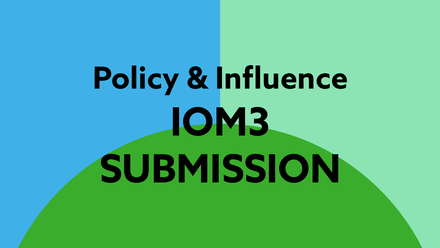IP for advanced materials
In tough times how can advanced materials innovators future-proof their businesses during? Jason Teng, of Potter Clarkson, shares his tips for a strong IP strategy.

The most successful businesses have been quick to adapt in recent months and those with ambitious growth targets will seek to innovate their way out of the current COVID-19 crisis. In the fast-paced world of advanced materials, future innovation will be defined by the decisions being made in the thick of the pandemic. Even though resources are constrained for many organisations, they cannot afford to stand still. From 2D materials, plastics and smart fabrics to composites, biomaterials and materials analytics, there is scope to not only reinvigorate existing manufacturing sectors but to also create new ones.
Often, the creation of a new advanced material can provide the needed breakthrough for an entire industry, thus highlighting the critical importance of the innovation process.
Despite this extraordinary potential for growth, businesses in the sector are faced with an entirely new trading environment and grappling with operational challenges on multiple fronts. However, forward-thinking businesses are taking action to put themselves and their innovations in the strongest position to succeed.
As we enter a new economic reality, innovators will need to review and re-prioritise their business goals, and it is vital that intellectual property (IP) strategies adapt accordingly to best support these new goals.To help realign your IP approach, I will take you through a four-step process.
Step one – review
To get a comprehensive assessment of your current IP position, focus on the following key areas:
Audit your IP assets
Ensure you have a central log of all IP assets the company owns and compare it with your key projects and brands to see if it aligns with your commercial priorities.
Are you familiar with the different types of IP rights and understand how they can be used to protect your materials innovations? What aspects of your technology is protected?
When it comes to advanced materials, what can be protected covers a wide range of technical subject-matter including material composition and structure, intermediate and end products, specific uses of the material, manufacturing processes and hardware, and material design procedures. As well as looking for gaps in protection, are there savings to be made by allowing some IP assets to lapse? A thorough audit will help answer these questions and perhaps raise other questions that have not been previously considered.
Ensure your procedures are fit for purpose
Assess whether your previous IP procedures measure up to the operational and financial pressures placed on your company by a more challenging operating environment. For example, consider how your approach to innovation capture might need to be adapted, especially with employees working remotely or in smaller teams. Consistent record-keeping is essential to not only ensure the availability of data for writing patent applications, but also for a clear paper trail for assessing inventorship and ownership rights. Employees need to be aware of confidentiality protocols and risks, especially when working in shared research facilities and sharing information online under working from home conditions.
Identify priority pipeline projects
As well as existing IP assets, it is important to keep track of your innovation pipeline. What known innovations have been developed and might need to be patented soon? Do you have a new brand on the cusp of being launched that might need trade mark protection? Do your existing IP rights already cover the new innovations and brands, or do you need to apply for new rights? Holding regular review meetings can help to identify needs for protection in a timely manner and also help with time and budget planning.
Review your available resources
Inevitably, the pandemic is placing pressure on resources, both in terms of people and funding. Consider how this might affect your ability to meet your commercial objectives. If you foresee potential pressure points, consider whether external consultants can help to fill any of the gaps.
Evaluate your strategic relationships
Most materials companies do not go it alone and have other stakeholders – collaborators, licensing partners and a supply chain – that they rely upon and who will also be affected by the pandemic. Check that any contracts are as you want them to be and give appropriate rights under the current circumstances. Registered IP rights are often mentioned in commercial agreements to outline the scope of those rights as a way of providing clarity and certainty to each party. If there is any discrepancy, then this may be an appropriate opportunity to leverage a variation to the agreement. If the current conditions are forcing you to operate – such as to manufacture – in a new location, ensure that you have a handle on how any geographical restrictions on your IP rights fit in with these new plans and whether those plans might lead to any infringement issues with other parties’ rights.
Monitor economic indicators
As the pandemic unfolds, it is bringing unprecedented economic, political, technological and social change. It would be wise to consider how these changes may manifest and impact on your IP position. These changes may very well lead to unexplored commericalisation opportunities that are tied to your existing IP rights.
Step two – consolidate
With a comprehensive assessment of the current IP position, a business is in the best possible position to assess where to invest time and resources and where to cut back.
Start by determining how business-critical each of your live projects are ranking them high, medium or low. Then apply a traffic light system, identifying which projects absolutely must continue during the current crisis, which projects can be paused for a short time and which projects should be stopped.
For live matters, keep track of the measures that have been introduced by IP offices around the world because of COVID-19, they could prove useful when having to juggle priorities.
Do bear in mind though that it remains incredibly important for IP to be protected during this period to avoid costly problems further down the line. For example, businesses of all sizes should be mindful of the fact that patents are, by their nature, slow burn, often with years passing between filing and grant. Furthermore, it takes time for some materials innovations to reach Technology Readiness Levels suitable for commercialisation, and so it may be a while before the value of the IP rights is fully realised. Curbing investment too excessively now could affect commercial advantages for many years to come.
Step three – managing risk
Disputes
For innovators, much of the risk relates to disputes with others – either you are asserting your IP rights to protect your business from others copying, or defending your company from accusations that you are infringing the IP rights of others. With the tendency of many companies to operate in the same space within the advanced materials sector, the risk of a dispute is not insignificant.
It is anticipated that, as businesses and brand owners try to cling to market share, there will be an escalation in disputes.
Disputes in themselves can be fraught with risk and, at a time where many organisations are operating with limited resources, it is advisable to carefully consider the merits of pursuing a case versus the cost of taking action. As always, if there is scope for a viable commercial settlement, explore it. For example, Alternative Dispute Resolution could prove particularly useful at this time, with both arbitration and mediation bodies operating remotely. Also, ownership of IP assets can create cross-licensing opportunities for mutual benefit, avoiding costly and time-consuming disputes.
Diversification
Many businesses have had to make changes to the way they make their products and deliver services. For example, some businesses may have been forced to move their manufacturing to a new location, or possibly alter their global transport routes to sale. This may be down to economic pressures or for regulatory or supply chain reasons. As a result, IP protection may be needed in territories where it does not currently exist. Also, while they may not have been originally envisaged as important, licensing opportunities and infringement risks may now have arisen in those new territories and have to be carefully considered. Both short and long-term changes to IP strategies may be needed.
Step four – planning ahead
Innovation will not stop – successful industries in key technology areas will be defined by work done during this period. There is an opportunity now to get ahead of the competition and use any additional time you have to think about future projects. Building an IP strategy into your business plan at an early stage allows for reliable prediction of future needs and creates flexibility for businesses to meet IP challenges arising from unexpected changes, which is especially crucial in the current uncertain climate.
If new business opportunities have arisen for you, there may be important steps you need to take to support long-term sustainability and future growth. This could include clearance searches, freedom to operate assessments, filings to seek IP protection, or drafting commercial agreements. Now is the time to discuss new projects to ensure these opportunities are not missed and you are well prepared to take any necessary action.
Unlocking growth with robust IP
As the present challenges begin to subside and we seek a new, sustainable normality, the stakes could not be higher. As a key driver of innovation, how companies leverage their IP rights will be hugely important. In the UK alone, IP-intensive industries account for one in three jobs and over 40% of GDP, making them of key strategic value to the overall health of the economy.







